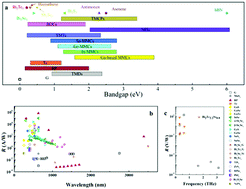当前位置:
X-MOL 学术
›
Chem. Soc. Rev.
›
论文详情
Our official English website, www.x-mol.net, welcomes your
feedback! (Note: you will need to create a separate account there.)
2D library beyond graphene and transition metal dichalcogenides: a focus on photodetection
Chemical Society Reviews ( IF 40.4 ) Pub Date : 2018-07-10 00:00:00 , DOI: 10.1039/c8cs00255j Feng Wang 1, 2, 3, 4, 5 , Zhenxing Wang 1, 2, 3, 4, 5 , Lei Yin 1, 2, 3, 4, 5 , Ruiqing Cheng 1, 2, 3, 4, 5 , Junjun Wang 1, 2, 3, 4, 5 , Yao Wen 1, 2, 3, 4, 5 , Tofik Ahmed Shifa 1, 2, 3, 4, 5 , Fengmei Wang 1, 2, 3, 4, 5 , Yu Zhang 1, 2, 3, 4, 5 , Xueying Zhan 1, 2, 3, 4, 5 , Jun He 1, 2, 3, 4, 5
Chemical Society Reviews ( IF 40.4 ) Pub Date : 2018-07-10 00:00:00 , DOI: 10.1039/c8cs00255j Feng Wang 1, 2, 3, 4, 5 , Zhenxing Wang 1, 2, 3, 4, 5 , Lei Yin 1, 2, 3, 4, 5 , Ruiqing Cheng 1, 2, 3, 4, 5 , Junjun Wang 1, 2, 3, 4, 5 , Yao Wen 1, 2, 3, 4, 5 , Tofik Ahmed Shifa 1, 2, 3, 4, 5 , Fengmei Wang 1, 2, 3, 4, 5 , Yu Zhang 1, 2, 3, 4, 5 , Xueying Zhan 1, 2, 3, 4, 5 , Jun He 1, 2, 3, 4, 5
Affiliation

|
Two-dimensional layered materials (2DLMs) have attracted a tremendous amount of attention as photodetectors due to their fascinating features, including high potentials in new-generation electronic devices, wide coverage of bandgaps, ability to construct van der Waals heterostructures, extraordinary light–mass interaction, strong mechanical flexibility, and the capability of enabling synthesis of 2D nonlayered materials. Until now, most attention has been focused on the well-known graphene and transition metal dichalcogenides (TMDs). However, a growing number of functional materials (more than 5619) with novel optoelectronic and electronic properties are being re-discovered, thereby widening the horizon of 2D libraries. In addition to showing common features of 2DLMs, these new 2D members may bring new opportunities to their well-known analogues, like wider bandgap coverage, direct bandgaps independence with thickness, higher mechanical flexibility, and new photoresponse phenomena. The impressive results communicated so far testify that they have shown high potentials with photodetections covering THz, IR, visible, and UV ranges with comparable or even higher performances than well-known TMDs. Here, we give a comprehensive review on the state-of-the-art photodetections of two-dimensional materials beyond graphene and TMDs. The review is organized as follows: fundamentals of photoresponse first are discussed, followed by detailed photodetections of new 2D members including both layered and non-layered ones. After that, photodiodes and hybrid structures based on these new 2D materials are summarized. Then, the integration of these 2D materials with flexible substrates is reviewed. Finally, we conclude with the current research status of this area and offer our perspectives on future developments. We hope that, through reading this manuscript, readers will quickly have a comprehensive view on this research area.
中文翻译:

石墨烯和过渡金属二卤化物以外的2D库:专注于光检测
二维分层材料(2DLM)由于其引人入胜的特性而成为光电探测器,引起了广泛的关注,包括新一代电子设备的高潜力,宽带隙的广泛覆盖,构造范德华力异质结构的能力,非凡的光质量相互作用,强大的机械柔韧性以及实现2D非分层材料合成的能力。迄今为止,最受关注的焦点是众所周知的石墨烯和过渡金属二卤化碳(TMD)。然而,越来越多的具有新颖的光电和电子特性的功能材料(超过5619种)正在被重新发现,从而拓宽了2D库的视野。这些新的2D成员除了展示2DLM的共同特征外,还可能为其知名的类似物带来新的机遇,例如更宽的带隙覆盖范围,带隙厚度的直接带隙独立性,更高的机械柔韧性和新的光响应现象。迄今为止所传达的令人印象深刻的结果证明,它们在THz,IR,可见光和UV范围内的光电检测具有很高的潜力,其性能可与知名的TMD媲美甚至更高。在这里,我们对除石墨烯和TMD之外的二维材料的最新光电检测进行了全面回顾。审查的组织方式如下:首先讨论光响应的基本原理,然后对新的2D成员(包括分层成员和非分层成员)进行详细的光电检测。之后,总结了基于这些新的2D材料的光电二极管和混合结构。然后,回顾了这些2D材料与柔性基板的集成。最后,我们以该领域的当前研究状况作为结束,并就未来的发展提供我们的观点。我们希望,通过阅读此手稿,读者将很快对这一研究领域有一个全面的了解。
更新日期:2018-07-10
中文翻译:

石墨烯和过渡金属二卤化物以外的2D库:专注于光检测
二维分层材料(2DLM)由于其引人入胜的特性而成为光电探测器,引起了广泛的关注,包括新一代电子设备的高潜力,宽带隙的广泛覆盖,构造范德华力异质结构的能力,非凡的光质量相互作用,强大的机械柔韧性以及实现2D非分层材料合成的能力。迄今为止,最受关注的焦点是众所周知的石墨烯和过渡金属二卤化碳(TMD)。然而,越来越多的具有新颖的光电和电子特性的功能材料(超过5619种)正在被重新发现,从而拓宽了2D库的视野。这些新的2D成员除了展示2DLM的共同特征外,还可能为其知名的类似物带来新的机遇,例如更宽的带隙覆盖范围,带隙厚度的直接带隙独立性,更高的机械柔韧性和新的光响应现象。迄今为止所传达的令人印象深刻的结果证明,它们在THz,IR,可见光和UV范围内的光电检测具有很高的潜力,其性能可与知名的TMD媲美甚至更高。在这里,我们对除石墨烯和TMD之外的二维材料的最新光电检测进行了全面回顾。审查的组织方式如下:首先讨论光响应的基本原理,然后对新的2D成员(包括分层成员和非分层成员)进行详细的光电检测。之后,总结了基于这些新的2D材料的光电二极管和混合结构。然后,回顾了这些2D材料与柔性基板的集成。最后,我们以该领域的当前研究状况作为结束,并就未来的发展提供我们的观点。我们希望,通过阅读此手稿,读者将很快对这一研究领域有一个全面的了解。











































 京公网安备 11010802027423号
京公网安备 11010802027423号